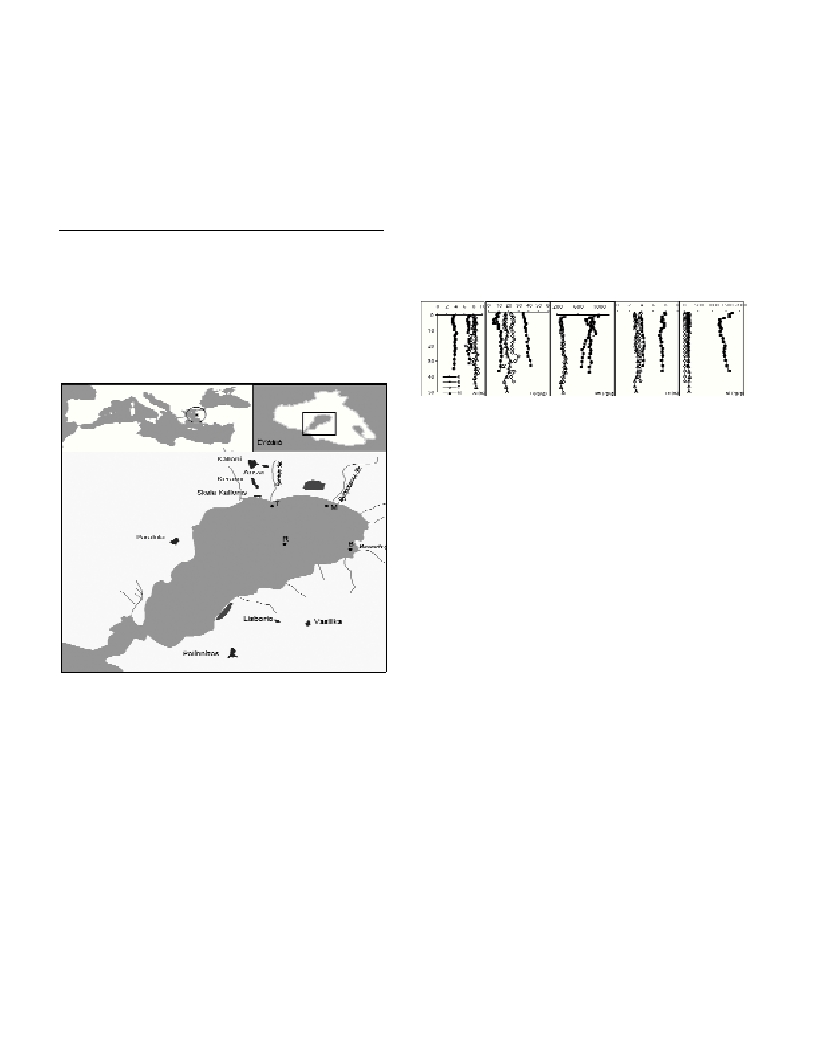METAL GEOCHEMISTRY IN SEDIMENTS OF A SEMI-ENCLOSED BAY IN THE
ISLAND OF LESVOS, GREECE
Apostolos M. Gavriil and Michael O. Angelidis*
Department of Environmental Studies, University of the Aegean, Greece
University Hill, 81100 Mytilene, Lesvos, Greece - magel@aegean.gr
Abstract
The concentrations of Al, Li, Fe, Mn and Ni were determined in sediment cores from the semi-enclosed Kalloni Bay, in the island of
Lesvos, Greece. The mineralogical variations in the different drainage basins and especially the ultramafic minerals in the drainage basin
of the stream Vouvaris, appear to be the main reason for the Mn, Fe and Ni enrichments in the sediments of the eastern part of the Bay.
Diagenetic processes also in?uenced the concentrations of Mn in the sediments of the central part of the Bay.
Keywords: metals, marine sediments, geochemistry, Kalloni Bay.
Rapp. Comm. int. Mer Médit., 37,2004
201
Introduction
Coastal marine sediments are the major depositories for persistent
substances such as heavy metals and their mineralogy is greatly
affected by of the geological background of the neighboring
landmasses. A detailed knowledge of the parameters that may affect
the natural metal variability is necessary in order to evaluate the
possible anthropogenic impact from pollution sources. In the present
study natural ?uctuations in metal concentrations were studied in
sediment cores from a semi-enclosed shallow marine system, Kalloni
Bay, in the island of Lesvos, Greece (Fig.1).
Fig. 1. Sampling stations
Materials and methods
Sediment cores were collected at four stations in the Bay during
March 2000. Three cores (stations B, M and T) were collected near
the mouths of the major streams of the area and a core was collected
from the inner part of the Bay (station R). The cores were sliced and
analyses were performed in the <1mm fraction using AAS [1].
Results and discussion
The concentrations of Al and Li in core B (3.80
±
0.22% and
10.7
±
2.4
µ
g/g respectively) were aproximately half in comparison to
the corresponding values in the other cores. Higher values were found
in the finer aluminosilicate material, which escapes from the coastal
zone and is deposited to the central parts of the Bay (Station R). Both
elements did not present significant ?uctuations along the cores depth.
Manganese concentrations in cores R and B were about three times
higher compared to cores M and T. The high concentrations of Mn in
core B were attributed to the geological background of stream
Vouvaris watershed, which consists of ultrabasic rocks [2]. In the core
R, at the centre of the Bay, Mn enhancement could be attributed to Mn
remobilization from other parts of the Bay. Manganese, because of its
redox sensitivitie, may be removed from the solid phase of the
sediment, transported through water and re-deposited elsewhere,
when oxic conditions occur [3]. The mobilization of Mn from the
sediments and its diffusion through pore water to the water column, is
supported by the high concentrations of the element near the surface
in all cores (Fig.2).
Fig. 2. Profiles of metal concentrations in the sediments of the Bay of
Kalloni.
Iron concentrations were much higher in station B (7.5
±
0.2 %) than
in the other stations (3.1
±
0.2% - 4.2
±
0.2%). The weathering of
ultrabasic rocks rich in Fe in the drainage basin of the stream Vouvaris
[2] is again the reason for Fe enhancement. No significant variations
were found along the cores probably because of the relatively
restricted remobilization of Fe. In contrast to the oxidation of Mn (II)
to Mn (IV), the oxidation of Fe is very rapid [4]. As a consequence,
when ions Fe
2+
were diffused through pore water into oxygenated
water column, they are immediately oxidized and precipitated before
being transported.
The concentrations of Ni in core B were one to two orders of
magnitude higher than the other cores (1438
±
134
µ
g/g in core B and
158
±
7, 165
±
18 and 15
±
3
µ
g/g respectively in cores R, M and T). The
high Ni values were also attributed to the geological background of
Vouvaris watershed, exclusively consisting of ultrabasic rocks
(peridotites) and nickeliferous minerals rich in Ni [2].
Conclusions
The ultrabasic minerals of the drainage basin of Vouvaris appears to
be the main reason for the marked enhancement of Fe, Mn and Ni in
the coastal sediments at the eastern part of the Bay of Kalloni. The
natural distribution of metals in the Bay of Kalloni is greatly
in?uenced by the local geology on a relatively small scale. On the
other hand, the redox sensitive Mn, which is also deposited on the
coastal zone near the stream Vouvaris, is more easily remobilized and
transported to greater distance, in?uencing the Mn distribution in the
central part of the Bay.
References
1-Loring, D.H., and Rantala, R.T.T., 1992. Manual for the geochemical
analyses of marine sediments and suspended particulate matter, Earth
Science Reviews, 32: 235-283.
2-Varnavas, S., 1989. Pollution of Kalloni Bay in Lesbos by toxic metals,
Proceedings of the 1
st
Congress of Environmental Science (Lekkas, Th.,
ed.), Mytilene, pp. 211-220.
3-Stumm, W., and Morgan, J.J., 1981. Aquatic chemistry. An
introduction emphasizing chemical equilibria in natural waters. 2nd
Edition. J.Wiley & Sons, N.York. 780 p.
4-Emerson, D., 2000. Microbial oxidation of Fe(II) and Mn(II) at
circumneutral pH. Pp. 31-52. In: Lovley, D.R., (Ed.), Environmental
Microbe-Metal Interactions. ASM Press, Washington.

